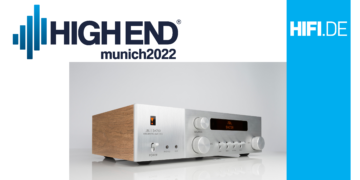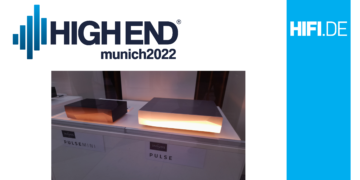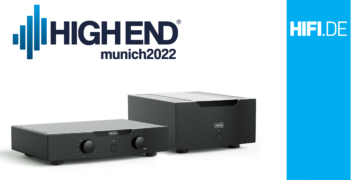| HIFI-FORUM » Stereo » Kopfhörer allgemein » Blindtest zum KHV „nach Wunsch“ | |
Gehe zu Seite: |vorherige| Erste Letzte
|
|
||||
Blindtest zum KHV „nach Wunsch“+A -A |
||
| Autor |
| |
|
ambiko
Ist häufiger hier |
#51
erstellt: 28. Mrz 2008, 08:21

|
|
|
Es erwartet wohl keiner ernsthaft, daß solche Threads mit einer "Lösung" enden, oder? Aber ab und zu werden dabei einige Argumente und Sichtweisen dargestellt, bei denen es sich lohnt etwas drüber nachzudenken um es eventuell in das eigene Meinungsbild mit einfließen zu lassen. Völlig unabhängig davon, von welcher Seite die Argumente kommen und wo der eigene Standpunkt ist. So ein Forum ist ja dafür da, damit man eben gerade nicht im eigenen Meinungs-Saft brät, sondern den Themenkreis von vielen Seiten betrachten kann. |
||
|
Nickchen66
Inventar |
#52
erstellt: 28. Mrz 2008, 11:50

|
|
|
Ich habe schon vor langer Zeit aufgegeben, bei solchen Diskussionen "volles Rohr" mitzumischen. Erstens halte ich meine eigene Einstellung dazu nicht für den heiligen Gral, und zweitens bin ich mit über 40 von ellenlangen Diskussionen viel schneller gelangweilt als damals in meinen rechthaberischen zornigen 20ern. |
||
|
roli1234
Neuling |
#53
erstellt: 01. Apr 2008, 09:39

|
|
|
hallo xTr3Me neulich habe ich eine "amtliche" Sammlung von Testtönen gefunden:  http://www.ebu.ch/en...s/tech3253/index.php http://www.ebu.ch/en...s/tech3253/index.phpHier ist der Link zum dazugehörigen "Booklet":  http://www.ebu.ch/CMSimages/en/tec_doc_t3253_tcm6-10525.pdf http://www.ebu.ch/CMSimages/en/tec_doc_t3253_tcm6-10525.pdfGrüsse, roli Hier ein paar Kategorien für Klangbeschreibungen anhand von EBU-Dokumenten: (Dokument A) Artefact category and explanation 1 Signal correlated noise: coloured noise associated with the signal 2 Loss of High Frequency: lack of high frequencies, dull sounding 3 Excess of High Frequency: excess of high frequencies or associated effects, e.g. sibilance or brightness 4 Periodic Modulation Effects: periodic variations such as warbling, pumping, or twitter 5 Temporal Distortion: pre- and post-echoes, smearing, effects associated with transients 6 Distortion: harmonic or inharmonic distortion 7 Loss of Low Frequency: lack of low frequencies, i.e. missing of “basse fondamentale” 8 Image Quality: all aspects including narrowing, spreading, movement, stability and audio objects remaining in their original position 9 High frequency distortion: distortion in the high frequencies, including phasey distortions (Dokument B) Acoustical balance The subjective impression of the relation between the direct and indirect (reflected) sounds. Acoustical noise Unwanted sounds in the room of origination, caused by, for example, air–conditioning equipment, lighting, movement of chairs; or noises carried by the structure of the building, such as impacts from outside, traffic noise, etc. Apparent room size The subjective impression of the apparent size, real or artificial, of the origination room. Bit errors Discrete noises or distortions originating in a digital system. Depth perspective The subjective impression that the sound image has an appropriate front to back depth. (Listeners should be aware when assessing this sub–parameter that it may be an artefact of the listening conditions rather than a parameter of a two channel stereo recording.) Directional balance The subjective impression that the sound sources within the sound image are placed in a way which makes the entire image balanced. Distortions Deterioration of the sound quality which may be due to defects or non–linearity in the recording or reproducing systems. Dynamic range The subjective impression of the range between the strongest and weakest levels during reproduction, relative to the expectation of the listener for programme material of the type. Electrical noise and distortions Unwanted signal components caused by the electro–acoustical transmission channel or signal processing, such as: noise, clicks, non–linear distortions and fading. FREEDOM FROM NOISE AND DISTORTIONS Absence of various disturbing phenomena such as electrical, acoustical noise, public noise, bit errors, distortions, etc. Homogeneity of the spatial sound The subjective impression that the sound space is a homogeneous whole. Integrity The subjective impression of an appropriate sound image for the performance so that the two appear as an integrated whole. Intelligibility The possibility to distinguish the words in spoken and sung text. Location accuracy The subjective impression that all sound sources are accurately positioned in the sound image. Loudness balance The subjective impression of the appropriate relative strength of the various sound sources. MAIN IMPRESSION A subjectively weighted value of the parameters Spatial impression, Stereo impression, Transparency, Balance, Timbre and Freedom from noise and distortion, taking into account the integrity of the total sound event and the interaction of the different parameters. Public noise The subjective impression of disturbances caused by the audience. Reverberance The subjective impression of the appropriate duration of natural or artificial indirect sounds. Sound attack The subjective impression of the speed at which sounds begin; a combination of the rate at which sounds increase over a very short period and the duration of that period. SOUND BALANCE The subjective impression of the balance of the individual sound sources in the general sound image. Sound colour The subjective impression of an appropriate sound for each source including all its characteristic harmonic elements. Sound colour of reverberation The subjective impression of a natural sound colour in the acoustics of the venue including any artificial reverberation. Sound image width The subjective impression of an appropriate width of the sound stage in the stereo sound field. Sound source definition The subjective impression that different instruments or voices sounding simultaneously can be identified and distinguished. SPATIAL IMPRESSION The subjective impression that the performance takes place in an appropriate spatial environment. Stability The subjective impression that all sound sources stay in their intended positions. STEREO IMPRESSION The subjective impression that the sound image has the correct and appropriate directional distribution of sound sources. Time definition The subjective impression that individual short sounds in rapid succession can be identified and differentiated. TIMBRE The subjective impression of the accurate portrayal of the different sound characteristics of the sound source(s) TRANSPARENCY The subjective impression that all details of the performance can be clearly perceived. |
||
| ||
|
|
||||
Gehe zu Seite: |vorherige| Erste Letzte
| Das könnte Dich auch interessieren: |
|
KHV ?nach Wunsch?? ThSp am 11.02.2008 – Letzte Antwort am 25.03.2008 – 27 Beiträge |
|
Abgetrennt: KHV-Klang (zum HD800) die X-te petitrouge am 04.05.2012 – Letzte Antwort am 21.05.2012 – 59 Beiträge |
|
KHV ChrisR am 12.02.2009 – Letzte Antwort am 12.02.2009 – 8 Beiträge |
|
Frage zum Portablen KHV Class_B am 15.01.2007 – Letzte Antwort am 15.01.2007 – 4 Beiträge |
|
KHV Frage zum Ausgangswiderstand wendy-t am 08.11.2016 – Letzte Antwort am 09.11.2016 – 17 Beiträge |
|
Welcher KHV zum AKG K701? willi112 am 04.08.2007 – Letzte Antwort am 11.08.2007 – 9 Beiträge |
|
Welcher KHV? czry am 09.04.2011 – Letzte Antwort am 10.04.2011 – 9 Beiträge |
|
KHV silber am 22.03.2005 – Letzte Antwort am 24.03.2005 – 10 Beiträge |
|
Mobile KHV JÄGERSCHNITZELJÄGER am 26.10.2015 – Letzte Antwort am 27.10.2015 – 6 Beiträge |
|
Vincent KHV-1 ax3 am 17.08.2006 – Letzte Antwort am 17.08.2006 – 2 Beiträge |
Anzeige
Produkte in diesem Thread

Aktuelle Aktion
Top 10 Threads in Kopfhörer allgemein der letzten 7 Tage

- Mein inEar Kopfhörer plötzlich auf der einen Seite leiser!
- Jabra Elite Active 75t - Lautstärke zu gering
- AirPods Pro Gehäuse - seitliche „Löcher“ ?
- In Ear nass geworden, sind sie auf Dauer geschädigt? Eine Seite leiser
- Schwindel und Übelkeit von NC-Kopfhörern
- Signal weg Sennheiser RS 120
- Jabra Elite 7 Pro schlechte Telefonqualität?
- InAirs - guenstigere Alternative zu comply foams?
- Schmerzen durch In-Ear-Kopfhörer
- Neuverkabelung vom DT 770
Top 10 Threads in Kopfhörer allgemein der letzten 50 Tage

- Mein inEar Kopfhörer plötzlich auf der einen Seite leiser!
- Jabra Elite Active 75t - Lautstärke zu gering
- AirPods Pro Gehäuse - seitliche „Löcher“ ?
- In Ear nass geworden, sind sie auf Dauer geschädigt? Eine Seite leiser
- Schwindel und Übelkeit von NC-Kopfhörern
- Signal weg Sennheiser RS 120
- Jabra Elite 7 Pro schlechte Telefonqualität?
- InAirs - guenstigere Alternative zu comply foams?
- Schmerzen durch In-Ear-Kopfhörer
- Neuverkabelung vom DT 770
Top 10 Suchanfragen

Forumsstatistik

- Registrierte Mitglieder928.252 ( Heute: 7 )
- Neuestes Mitgliedkopernik165#
- Gesamtzahl an Themen1.557.841
- Gesamtzahl an Beiträgen21.687.843












